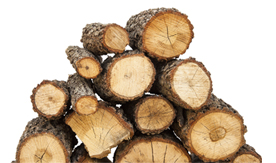 With the snow beginning to melt, firewood may be the last thing Maine residents want to think about, but according to University of Maine professor Jessica Leahy, spring and summer are the best times to start a wood bank, and her new guide shows communities how.
With the snow beginning to melt, firewood may be the last thing Maine residents want to think about, but according to University of Maine professor Jessica Leahy, spring and summer are the best times to start a wood bank, and her new guide shows communities how.
Leahy, an associate professor of human dimensions of natural resources at the University of Maine School of Forest Resources, wrote the guide with Sabrina Vivian, a senior in the Ecology and Environmental Sciences Program.
Wood banks are similar to food pantries, but instead of providing food for those in need, they provide firewood at little to no cost for those who rely on wood to heat their homes.
“A Community Guide to Starting & Running a Wood Bank” provides guidance for establishing a wood bank, as well as topics to be considered, including types of wood banks, location, legalities, security, eligibility, firewood sources, volunteers, processing, distribution and equipment.
“It walks everyone through the critical aspects of what makes a wood bank, a wood bank,” Leahy says.
The guide also includes profiles and contact information of New England wood banks, as well as a checklist designed for community members to use when holding an initial wood bank planning meeting.
In 2013, when Leahy and Vivian began researching wood banks in New England, they found 12 wood banks throughout the region, with only one in Maine — the Cumberland Wood Bank. All the wood banks started as grassroots organizations without knowing about each other and having to navigate on their own, Leahy says.
In November 2014, Leahy and Vivian wrote an opinion piece for the Bangor Daily News titled, “How wood banks could help Mainers avoid an eat-or-heat dilemma.” The op-ed generated a lot of interest, and many phone calls to Leahy asking how to get started and how to donate wood.
After the op-ed was published, Leahy also heard from two other existing wood banks in Maine — Vets Helping Vets in Camden and Boothbay Woodchucks in Boothbay. Residents in Waldo County and Bucksport were inspired by the piece and started their own wood banks. Blue Hill also is in the process of creating an organization, Leahy says.
Leahy and Vivian decided an online community guide would be helpful for those getting started, and Vivian spearheaded the project as part of her senior capstone.
The researchers say there is a demand for wood banks in the state. They use census data to determine communities that have a high percentage of families that heat with wood and experience economic distress, which would benefit from a wood bank. Since starting this winter, the Waldo County Wood Bank has supported 40 families, Leahy says.
Wood banks not only help those in need, but they also bring people together and provide an opportunity for neighbors to help neighbors, she adds.
Leahy, who focuses on forest resources, said she got involved with wood banks because she wanted to do something related to the woods that was responsive to the needs of state’s residents. Heating in winter is an economic stressor for many families in Maine, and Leahy says a potential solution lies in a renewable Maine resource.
“New England has a culture of heating with firewood,” Leahy says. “I can’t say how much I love that local, renewable resource and doing it the New England way with firewood as opposed to oil.”
Vivian grew up in Surry and Blue Hill in homes that were heated with wood. With renewable energy career interests and a dedication to her home state, she knew wood banks could positively affect many Maine communities.
“The wood bank concept is all about helping your neighbors while also contributing to a more local and sustainable lifestyle,” Vivian says. “You can’t beat the establishment of programs that bring communities together to support people — emotionally and physically — and do so in an environmentally conscious way.”
Vivian and Leahy plan to post on the School of Forest Resources website potential demand analysis maps for each of Maine’s counties to help communities determine if a wood bank would be beneficial in their respective areas. So far, most of their research has focused on demand. As more wood banks start up in Maine, the team plans to focus on supply and potential firewood sources.
For those thinking about starting a wood bank, Leahy says a key component is having someone in charge who is passionate about the cause and helping others. She also advises having a flexible organization structure and adapting through trial and error.
Leahy says spring and summer are ideal seasons to start wood banks because there is more time to build a supply, as well as process and dry wood.
The guide is available online. For more information on wood banks, contact Leahy at 581.2834, jessica.leahy@maine.edu.
Contact: Elyse Kahl, 207.581.3747
